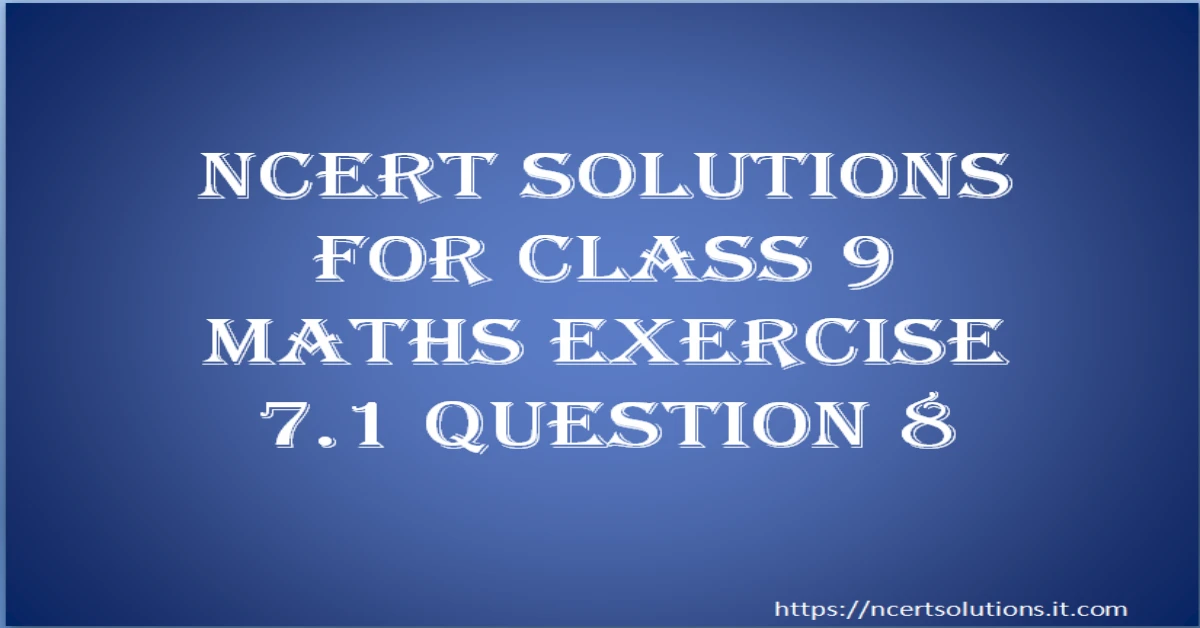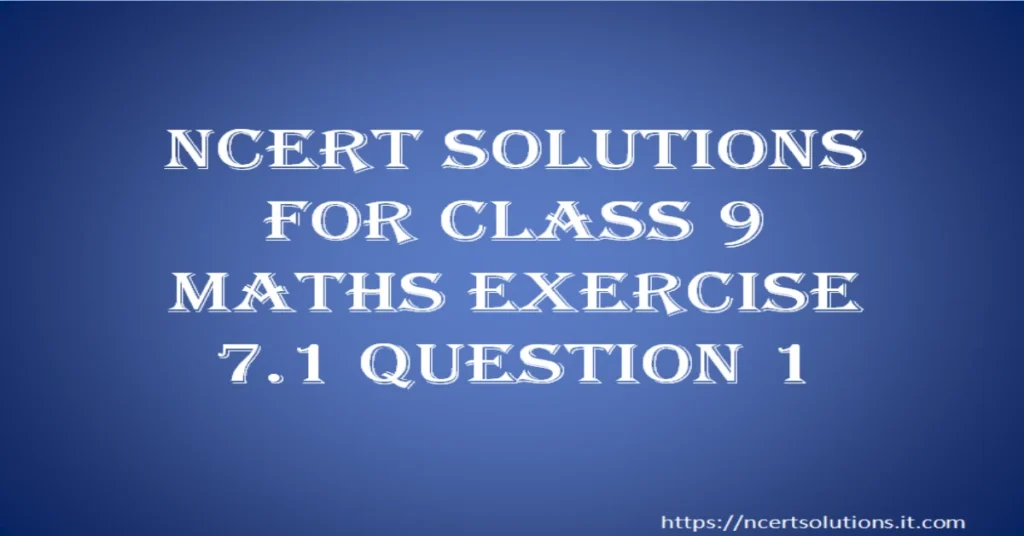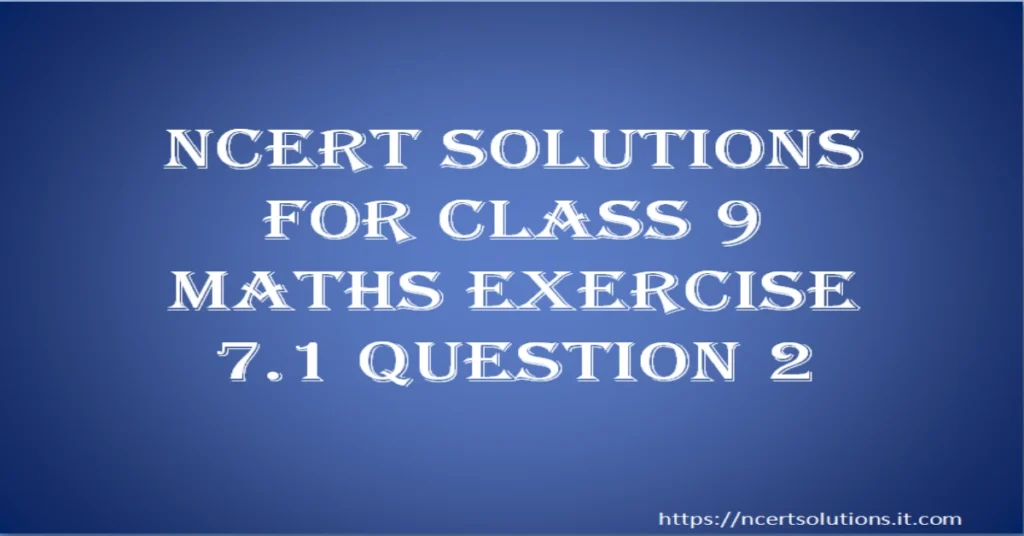NCERT Solutions for Class 9 Maths Exercise 7.1 Question 8

Understanding the Question 🧐
This is a very important question from the chapter on Triangles. It deals with a right-angled triangle and the properties of a special line segment called a median. We are given several conditions and asked to prove four different results one by one. This problem beautifully shows how the result of one proof can be used to solve the next part. Let’s dive into the detailed ncert solutions for each part.
In right triangle ABC, right angled at C, M is the mid-point of hypotenuse AB. C is joined to M and produced to a point D such that DM = CM. Point D is joined to point B. Show that:
(i) &&ΔAMC ≅ ΔBMD&&
(ii) &&∠DBC&& is a right angle.
(iii) &&ΔDBC ≅ ΔACB&&
(iv) &&CM = \frac{1}{2}AB&&

Part (i): Proving &&ΔAMC ≅ ΔBMD&& 📝
For the first part, we need to prove that triangle &&AMC&& is congruent to triangle &&BMD&&. We can do this using the Side-Angle-Side (SAS) congruence rule by identifying three pairs of equal parts.
In &&ΔAMC&& and &&ΔBMD&&:
- Side: &&AM = BM&&.
This is because it’s given that M is the mid-point of AB. - Angle: &&∠AMC = ∠BMD&&.
These are vertically opposite angles, which are always equal when two lines intersect. - Side: &&CM = DM&&.
This is given in the construction of the figure.
Since we have two sides and the included angle of &&ΔAMC&& equal to two sides and the included angle of &&ΔBMD&&, we can conclude by the SAS congruence rule that:
&&ΔAMC ≅ ΔBMD&&
Part (ii): Proving &&∠DBC&& is a Right Angle 📝
Now we use the result from Part (i). Since &&ΔAMC ≅ ΔBMD&&, their corresponding parts are equal (by CPCTC).
- From CPCTC, we get &&∠ACM = ∠BDM&&. These are alternate interior angles for lines &&AC&& and &&DB&& with transversal &&DC&&. So, &&AC || DB&&.
- Also from CPCTC, we get &&∠CAM = ∠DBM&& (or &&∠CAB = ∠DBA&&). These are also alternate interior angles, this time for lines &&AC&& and &&DB&& with transversal &&AB&&. This confirms &&AC || DB&&.
Now, let’s consider &&BC&& as a transversal intersecting the parallel lines &&AC&& and &&DB&&. The sum of consecutive interior angles is &&180°&&.
&&∠DBC + ∠ACB = 180°&&
We are given that &&ΔABC&& is a right-angled triangle at &&C&&, so &&∠ACB = 90°&&. Substituting this value:
&&∠DBC + 90° = 180°&&
&&∠DBC = 180° – 90°&&
&&∠DBC = 90°&&
Thus, &&∠DBC&& is a right angle.
Part (iii): Proving &&ΔDBC ≅ ΔACB&& 📝
To prove these two triangles congruent, we will again use the SAS rule, armed with the results from the previous parts.
In &&ΔDBC&& and &&ΔACB&&:
- Side: &&DB = AC&&.
This comes from Part (i), where we proved &&ΔAMC ≅ ΔBMD&&. &&DB&& and &&AC&& are corresponding sides (CPCTC). - Angle: &&∠DBC = ∠ACB = 90°&&.
We are given &&∠ACB = 90°&& and we proved &&∠DBC = 90°&& in Part (ii). - Side: &&BC = CB&&.
This is the common side to both triangles.
By the SAS congruence rule, we can conclude:
&&ΔDBC ≅ ΔACB&&
Part (iv): Proving &&CM = \frac{1}{2}AB&& 📝
This final proof is a direct result of the congruence we established in Part (iii).
- Since &&ΔDBC ≅ ΔACB&&, their corresponding sides are equal (CPCTC). Therefore, &&DC = AB&&.
- From the figure, we can see that the line segment &&DC&& is made up of &&DM + CM&&. So, &&DC = DM + CM&&.
- We were given in the construction that &&DM = CM&&.
- Substituting this into the equation from step 2, we get &&DC = CM + CM = 2CM&&.
Now we have two expressions for &&DC&&: &&DC = AB&& and &&DC = 2CM&&. By equating them:
&&2CM = AB&&
&&CM = \frac{1}{2}AB&&
Hence Proved!
Conclusion and Key Points ✅
This comprehensive four-part proof demonstrates a critical theorem in geometry. We started by proving &&ΔAMC ≅ ΔBMD&& using SAS. This allowed us to establish that &&AC || DB&&, which led to proving &&∠DBC = 90°&&. Using this right angle, we then proved &&ΔDBC ≅ ΔACB&&, again by SAS. Finally, using CPCTC on this last pair of congruent triangles, we proved that &&CM = \frac{1}{2}AB&&.
- SAS Congruence Rule: Two sides and the included angle.
- CPCTC: Corresponding Parts of Congruent Triangles are Congruent. A very powerful tool used after proving congruence.
- Parallel Lines Properties: If alternate interior angles are equal, lines are parallel. If lines are parallel, the sum of co-interior angles is &&180°&&.
- Median to Hypotenuse Theorem: The final result, &&CM = \frac{1}{2}AB&&, is a famous theorem. The median from the right angle to the hypotenuse is half the length of the hypotenuse.
FAQ
Q: How do you prove &&ΔAMC ≅ ΔBMD&& in the first part?
A: We use the Side-Angle-Side (SAS) congruence rule. The sides are &&AM = BM&& (since M is the midpoint) and &&CM = DM&& (given). The included angle is &&∠AMC = ∠BMD&& because they are vertically opposite angles.
Q: How do we prove that &&∠DBC&& is a right angle?
A: From the first congruence (&&ΔAMC ≅ ΔBMD&&), we get &&∠CAM = ∠DBM&& by CPCTC. These are alternate interior angles, which means &&AC&& is parallel to &&DB&&. Then, considering &&BC&& as a transversal, the sum of co-interior angles &&∠DBC&& and &&∠ACB&& is &&180°&&. Since &&∠ACB = 90°&&, &&∠DBC&& must also be &&90°&&.
Q: Which congruence rule is used to prove &&ΔDBC ≅ ΔACB&&?
A: The Side-Angle-Side (SAS) congruence rule is used again. We have side &&DB = AC&& (from the first proof), the included angle &&∠DBC = ∠ACB = 90°&&, and the common side &&BC = CB&&.
Q: What is the important property proved in the last part (&&CM = \frac{1}{2}AB&&)?
A: This proves a key theorem in geometry: the length of the median drawn from the vertex of the right angle to the hypotenuse in a right-angled triangle is exactly half the length of the hypotenuse.
Q: How is CPCTC used throughout this solution?
A: CPCTC (Corresponding Parts of Congruent Triangles are Congruent) is used twice. First, after proving &&ΔAMC ≅ ΔBMD&&, to get &&AC = BD&& and &&∠CAM = ∠DBM&&. Second, after proving &&ΔDBC ≅ ΔACB&&, to get &&DC = AB&&, which is essential for the final proof.
Q: What are vertically opposite angles?
A: When two straight lines intersect, they form an ‘X’ shape. The angles opposite each other at the intersection point are called vertically opposite angles, and they are always equal. Here, &&∠AMC&& and &&∠BMD&& are vertically opposite angles.
Further Reading
This question is a cornerstone of the “Triangles” chapter. To revise the concepts of congruence rules and properties of triangles, refer to your NCERT Class 9 Maths textbook. You can also find more resources on the official NCERT website: https://ncert.nic.in/.


